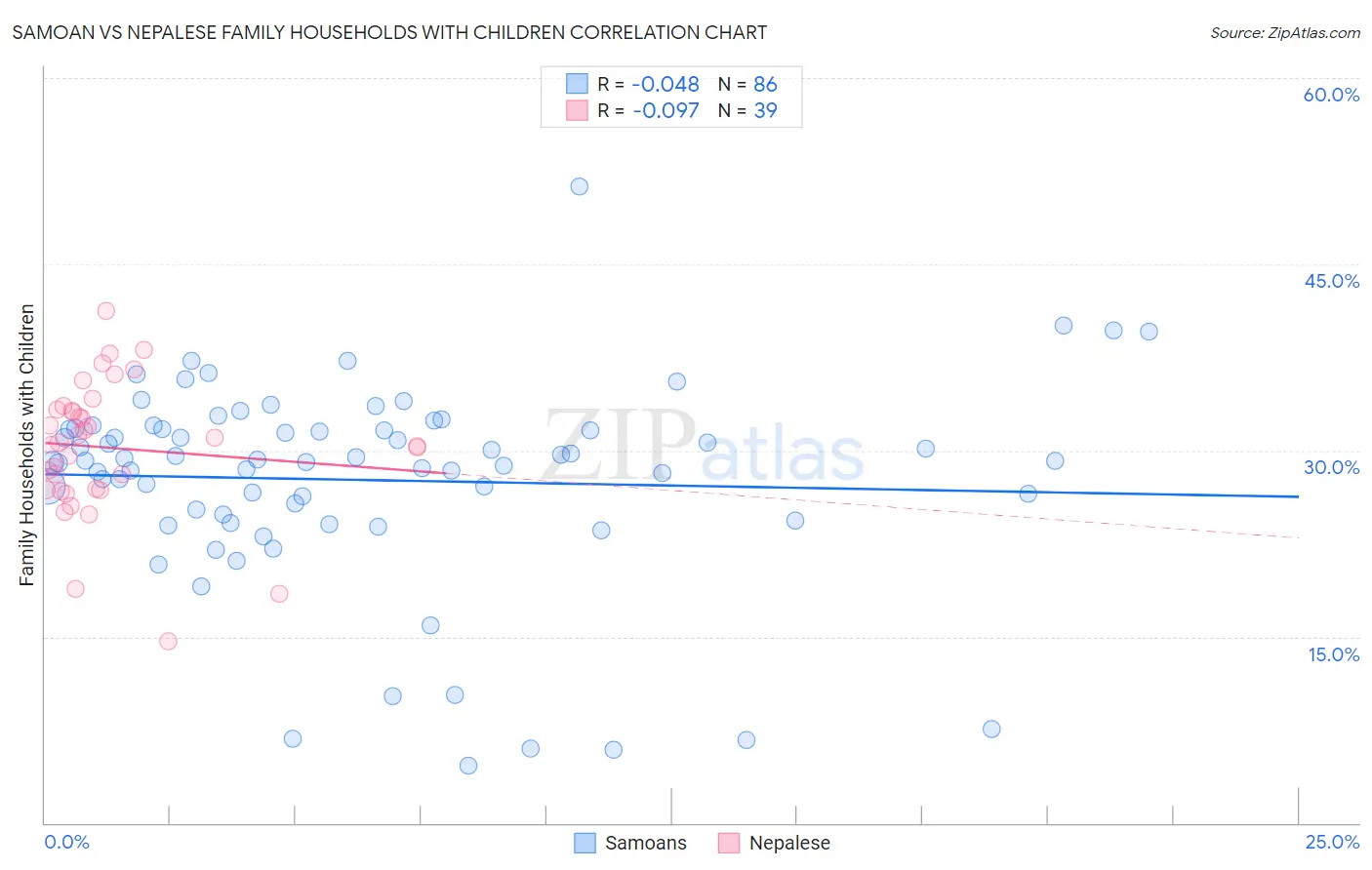Samoan vs Nepalese Family Households with Children
COMPARE
Samoan
Nepalese
Family Households with Children
Family Households with Children Comparison
Samoans
Nepalese
29.5%
FAMILY HOUSEHOLDS WITH CHILDREN
100.0/ 100
METRIC RATING
28th/ 347
METRIC RANK
30.5%
FAMILY HOUSEHOLDS WITH CHILDREN
100.0/ 100
METRIC RATING
11th/ 347
METRIC RANK
Samoan vs Nepalese Family Households with Children Correlation Chart
The statistical analysis conducted on geographies consisting of 225,025,987 people shows no correlation between the proportion of Samoans and percentage of family households with children in the United States with a correlation coefficient (R) of -0.048 and weighted average of 29.5%. Similarly, the statistical analysis conducted on geographies consisting of 24,519,269 people shows a slight negative correlation between the proportion of Nepalese and percentage of family households with children in the United States with a correlation coefficient (R) of -0.097 and weighted average of 30.5%, a difference of 3.5%.

Family Households with Children Correlation Summary
| Measurement | Samoan | Nepalese |
| Minimum | 4.6% | 14.7% |
| Maximum | 51.3% | 41.2% |
| Range | 46.7% | 26.5% |
| Mean | 27.6% | 30.2% |
| Median | 29.2% | 30.6% |
| Interquartile 25% (IQ1) | 24.8% | 26.8% |
| Interquartile 75% (IQ3) | 31.8% | 33.3% |
| Interquartile Range (IQR) | 6.9% | 6.5% |
| Standard Deviation (Sample) | 8.3% | 5.5% |
| Standard Deviation (Population) | 8.2% | 5.4% |
Demographics Similar to Samoans and Nepalese by Family Households with Children
In terms of family households with children, the demographic groups most similar to Samoans are Bolivian (29.5%, a difference of 0.0%), Immigrants from Vietnam (29.5%, a difference of 0.16%), Sri Lankan (29.5%, a difference of 0.18%), Immigrants from Latin America (29.7%, a difference of 0.63%), and Guamanian/Chamorro (29.7%, a difference of 0.73%). Similarly, the demographic groups most similar to Nepalese are Immigrants from Fiji (30.5%, a difference of 0.080%), Thai (30.6%, a difference of 0.40%), Immigrants from Pakistan (30.2%, a difference of 0.88%), Afghan (30.2%, a difference of 1.1%), and Bangladeshi (30.1%, a difference of 1.4%).
| Demographics | Rating | Rank | Family Households with Children |
| Thais | 100.0 /100 | #9 | Exceptional 30.6% |
| Immigrants | Fiji | 100.0 /100 | #10 | Exceptional 30.5% |
| Nepalese | 100.0 /100 | #11 | Exceptional 30.5% |
| Immigrants | Pakistan | 100.0 /100 | #12 | Exceptional 30.2% |
| Afghans | 100.0 /100 | #13 | Exceptional 30.2% |
| Bangladeshis | 100.0 /100 | #14 | Exceptional 30.1% |
| Immigrants | South Central Asia | 100.0 /100 | #15 | Exceptional 30.0% |
| Immigrants | Afghanistan | 100.0 /100 | #16 | Exceptional 30.0% |
| Hispanics or Latinos | 100.0 /100 | #17 | Exceptional 29.9% |
| Salvadorans | 100.0 /100 | #18 | Exceptional 29.9% |
| Alaska Natives | 100.0 /100 | #19 | Exceptional 29.9% |
| Immigrants | El Salvador | 100.0 /100 | #20 | Exceptional 29.8% |
| Immigrants | Laos | 100.0 /100 | #21 | Exceptional 29.8% |
| Malaysians | 100.0 /100 | #22 | Exceptional 29.8% |
| Mexican American Indians | 100.0 /100 | #23 | Exceptional 29.7% |
| Guamanians/Chamorros | 100.0 /100 | #24 | Exceptional 29.7% |
| Immigrants | Latin America | 100.0 /100 | #25 | Exceptional 29.7% |
| Sri Lankans | 100.0 /100 | #26 | Exceptional 29.5% |
| Immigrants | Vietnam | 100.0 /100 | #27 | Exceptional 29.5% |
| Samoans | 100.0 /100 | #28 | Exceptional 29.5% |
| Bolivians | 100.0 /100 | #29 | Exceptional 29.5% |